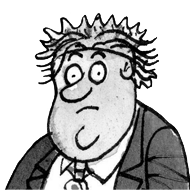It’s about this time every year that the Mother decamps to the farm in Lisnapookybawna. As soon as St Patrick’s Day is over, nearly every weekend is spent there.
The woman is full of ideas about what we should do with the place, but of course my preference would be to liquidate the asset and put the proceeds into my arse pocket. That won’t happen anytime soon – the Mother has fallen in love with life on the farm.
She’s not getting any younger and I was hoping she might begin to slow down a bit, but there isn’t a sign of that. When she goes out to Lisnapookybawna she works from morning to night, but I can’t say a word. If I even as much as drop a hint that she should restrict her activities, she takes umbrage.
“I suppose the next thing you’ll want me to do is get a walkin’ stick,” says she. “The day I do you’d be well advised to stay out of strikin’ range.”
All winter she’s been gathering literature from Teagasc, Leader, organic groups, the Greens and the ICA. She tells me she is exploring “a wide variety of options” in the farming sector, from rearing chickens to alpacas to cactus plants. She has even looked at snail farming, saying the pace of that particular enterprise would suit me perfectly.
There was a time when I’d challenge the Mother about all these things but I’ve reached that stage in life where I don’t bother anymore. I am more selective about the battles I fight – I like to win some and draw some and avoid the ones I’m sure to lose.
She announced a while ago that this would be the year of experimentation on the farm, ’twas like one of these five-year plans the communists used to go on about, the Chinese had one called “The Great Leap Forward”.
For our great leap forward into alternative farming, the Mother is trying a few different things, starting with alpacas. In case you don’t know, these animals are like a cross between a sheep and a camel and come from the Andes Mountains of South America, around Peru, Bolivia, Ecuador and northern Chile. Seemingly, they have lovely wool and, like myself, are placid, affectionate and easy to potty train.
In fact, unlike sheep, cattle, pigs, and horses who do their business wherever and whenever they feel like it, the alpacas do it at a specific time in a specific place and form an orderly queue.
Not wishing to labour this point, I’m at an age where any queue for the loo, be it orderly or disorderly, is the stuff of nightmare – when I need to go, I need to go. The similarities between the alpaca and myself don’t stretch that far.
The Mother agreed to take two alpacas on trial to see if they would suit her and suit conditions at Lisnapookybawna. The woman loaning us the animals came to inspect our farm and interview us to see if we would make “worthy foster parents for her babies”.
She put us through our paces about our love and care for animals and that had just about satisfied her when Stefan, the Mother’s Polish friend, asked if we could eat the alpacas.
The Mother aimed a swift kick under the table at him but missed and struck the alpaca woman on the shin. She screamed in pain and the Mother apologised, saying she suffered from a sudden locking of the knee that caused her to kick out indiscriminately. She also explained that we had no intention of eating her animals and that the word alpaca sounds very like the Polish word for pig. She said Stefan thought we were getting a rare breed of pig.
Stefan was about to protest when the Mother got another sudden ‘locking of the knee’ and this time hit her target with deadly accuracy, causing Stefan to curse aloud – thankfully in Polish.
The lady, somewhat reluctantly, agreed that we could have a pair of her alpacas for two weeks. The only complication was that we had to collect them and deliver them back. The Mother had a tow bar fitted to the Micra, hired a trailer and we collected the animals at the other side of Rathbinnis. We were like escapees from Noah’s ark as we made our way to Lisnapookybawna
When we got to the farm, our nosey neighbours, John Joe Ryan and Tom Brannigan, were waiting to see the exotic creatures.
“They look like a cross between a swan and a sheep,” says Brannigan.
“Wouldn’t it be great to have a neck like that,” says John Joe.
“Why?” says I.
“You’d be able to look in over the ditches without having to get off the saddle of the bike,” he said.
“You see enough with the neck you have,” said the Mother.






 This is a subscriber-only article
This is a subscriber-only article





SHARING OPTIONS: